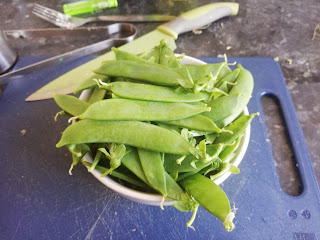I've been weighing up the pros and cons of growing peas on my allotment: the plants take up a lot of space, relative to how much edible plant matter you can actually pick from them. Another thing is, peas in the pod - and the pods themselves - are so delicious freshly picked, that actually gathering enough of them to be worth cooking is an exercise in willpower in itself. Not to mention leaving some of them swell into a full size peas as to have seeds for next year's crop. Peas test my patience.
 |
| Mostly peas. |
But yesterday, scouring the internets for unusual chutney recipes (because that's something I do) I stumbled across the idea of lacto-fermented peas. I was very happy about this: my lacto-fermenting wild garlic and spinach experiments of yestermonth have been a resounding success. It also provides the answer to the question of whether I should carry on growing peas. That answer is yes.
So, energised by the thought of preserving another edible green in a tasty and fridge-less way, I gathered up a bag of pods, and taking my lead from the recipes here and here, got cracking.
First I chopped the tips off.
Then I made my brine. I used about tablespoon of salt and added garlic, mint, coriander, and pepper. Nothing fancy. I could have added some chilli, too, but I was being cautious. I only used table salt, because that's all I have. Lacto-fermenting enthusiasts tend to recommend fancier salts, straight from the sea or the Himalayas, which still contain interesting minerals, so I might have to invest in some of them.
Lacto-fermenting is generally easier than pickling, in that totally "sterilising" your jars isn't really required. No hot water or heating the jars in the oven: as long as they're clean and dry, that'll do. It's all about cultivating healthy bacteria, after all.
Next I packed the pods into my jar, poured over the brine, and weighed down with a freezer bag with water in it. All you need is enough to press the contents down so that all the contents everything is are below the surface. This is easy to do.
Finally I sealed the jar and left it on a shelf, where it's already serving as a serviceable bookend.
Time will tell how delicious these may be, but I have very high hopes.
******
Here's a couple of my recent allotment videos. I now have 62 subscribers. These are very exciting times.




Related posts
Shelf Life
Eating From the Bottomless Pickle Jar
Wild Garlic Experiments
Garlic and Other Surprises
Please consider disabling your adblockers when reading this site. I make every effort to ensure no inappropriate, rubbish or offensive advertising appears here, and nothing that is contrary to the spirit of this blog. So it's really nothing to be afraid of. Cheers.






Comments
Post a Comment
Your comments are welcome.